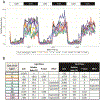Developmental toxicity in zebrafish (Danio rerio) exposed to uranium: A comparison with lead, cadmium, and iron
- PMID: 33246768
- PMCID: PMC7785642
- DOI: 10.1016/j.envpol.2020.116097
Developmental toxicity in zebrafish (Danio rerio) exposed to uranium: A comparison with lead, cadmium, and iron
Abstract
Populations of plants and animals, including humans, living in close proximity to abandoned uranium mine sites are vulnerable to uranium exposure through drainage into nearby waterways, soil accumulation, and blowing dust from surface soils. Little is known about how the environmental impact of uranium exposure alters the health of human populations in proximity to mine sites, so we used developmental zebrafish (Danio rerio) to investigate uranium toxicity. Fish are a sensitive target for modeling uranium toxicity, and previous studies report altered reproductive capacity, enhanced DNA damage, and gene expression changes in fish exposed to uranium. In our study, dechorionated zebrafish embryos were exposed to a concentration range of uranyl acetate (UA) from 0 to 3000 μg/L for body burden measurements and developmental toxicity assessments. Uranium was taken up in a concentration-dependent manner by 48 and 120 h post fertilization (hpf)-zebrafish without evidence of bioaccumulation. Exposure to UA was not associated with teratogenic outcomes or 24 hpf behavioral effects, but larvae at 120 hpf exhibited a significant hypoactive photomotor response associated with exposure to 3 μg/L UA which suggested potential neurotoxicity. To our knowledge, this is the first time that uranium has been associated with behavioral effects in an aquatic organism. These results were compared to potential metal co-contaminants using the same exposure paradigm. Similar to uranium exposure, lead, cadmium, and iron significantly altered neurobehavioral outcomes in 120-hpf zebrafish without inducing significant teratogenicity. Our study informs concerns about the potential impacts of developmental exposure to uranium on childhood neurobehavioral outcomes. This work also sets the stage for future, environmentally relevant metal mixture studies. Summary Uranium exposure to developing zebrafish causes hypoactive larval swimming behavior similar to the effect of other commonly occurring metals in uranium mine sites. This is the first time that uranium exposure has been associated with altered neurobehavioral effects in any aquatic organism.
Keywords: Development; Metals; Neurobehavior; Uranium; Zebrafish.
Copyright © 2020 Elsevier Ltd. All rights reserved.
Conflict of interest statement
Declaration of competing interest The authors declare that they have no known competing financial interests or personal relationships that could have appeared to influence the work reported in this paper.
Figures




References
-
- Abdelouas A 2006. Uranium mill tailings: Geochemistry, mineralogy, and environmental impact. Elements. 2(6):335–341.
-
- Andrade TS, Henriques JF, Almeida AR, Soares AM, Scholz S, Domingues I. 2017. Zebrafish embryo tolerance to environmental stress factors-concentration-dose response analysis of oxygen limitation, ph, and uv-light irradiation. Environ Toxicol Chem. 36(3):682–690. - PubMed
-
- Annamalai SK, Arunachalam KD. 2017. Uranium ((238)u)-induced ros and cell cycle perturbations, antioxidant responses and erythrocyte nuclear abnormalities in the freshwater iridescent shark fish pangasius sutchi. Aquat Toxicol. 186:145–158. - PubMed
-
- Audira G, Sampurna BP, Juniardi S, Liang S-T, Lai Y-H, Hsiao C-D. 2018. A versatile setup for measuring multiple behavior endpoints in zebrafish. Inventions. 3(4):75.
MeSH terms
Substances
Grants and funding
LinkOut - more resources
Full Text Sources
Other Literature Sources

